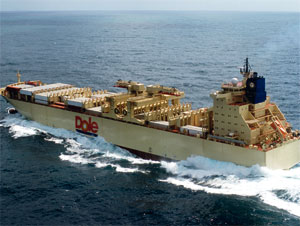Making sure it tastes good: direct or frozen juice from across the ocean.
We usually don’t think about where our orange juice comes from – we simply drink it. But it has often been underway for weeks – usually from Brazil – which demands flawless cooling. A challenge for GEA Refrigeration Technologies: GEA has equipped man juice carriers with refrigeration systems. These freighters transport direct only juice or concentrate. In addition, GEA has modernized and retrofitted older ships.

Direct juice is pasteurized and filled immediately after pressing. It is designated on its labels as “not from concentrate” (NFC). Today, however, the greatest share of orange juice is shipped in the form of concentrate, from which water and aroma have been removed. The process of concentration reduces its volume to around one-sixth of the pressed juice. It is designated as “frozen concentrated orange juice” (FCOJ) and is transported at a frosty - 10 °C. At its destination, water and aroma are returned to the concentrate. This variation of juice is accordingly cheaper at retail dealers. As part of growing. quality consciousness and the higher standard of living of many consumers, however, the demand for direct juice is growing.

A typical juice carrier transports approximately 32,000 m3 of juice per trip. This is equivalent to 32 million one-liter cartons. The juice – whether in fresh or concentrated form – is stored in stainless steel tanks on board. The juice is pre-cooled before being stored on board, after which systems of GEA go into action. These systems must ensure a temperature of - 10 °C for the concentrated juice. Direct juice is stored just above the freezing point: a process in which precision is critical, since the juice must not by any means be allowed to freeze. Normally, a double, indirect system provides the refrigeration: ice packs cool a brine solution, which is pumped to the insulated cargo holds. There, air coolers cool the air around the tanks. In new ships, GEA prefers the refrigerant ammonia, owing to its environmentally friendliness. It is easy to implement the legal regulations that must be observed with this gas: for example, a separate and gas-tight compressor room. It is very difficult, or impossible, to observe such regulations in converted ships; as a result, other refrigerants (e.g., R404A) are applied in such cases.
Whichever type of juice is planned for transport, GEA is your highly competent contact partner. This applies not only when advanced technology must be integrated in new ships, but also when things are a bit tricky: for example, conversion under time pressure of an old freighter for the transport of juice.
Know-how for refrigeration processes on juice carriers:
- Implementation of new systems
- Conversion and retrofitting
of old ships - Chillers
- Air coolers
- Environmentally friendly refrigerants
